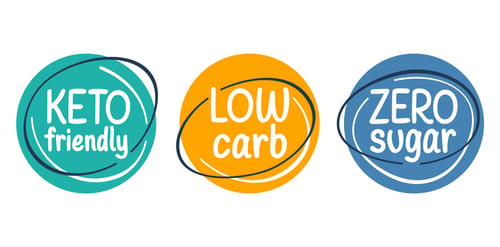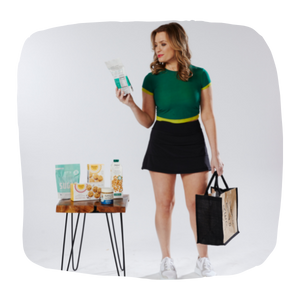Written By:
Wake Up and Read the Labels
The overwhelming majority of shoppers in grocery stores today don't remember a time when nutrition labels failed to exist, or at the very least, were mandatory. The further back you go in time, food was less complex and labels just weren't necessary. A bin of apples, after all, were simply apples.
Food, especially processed food, is far more complicated now, but health doesn’t have to be. Whole foods—plants, vegetables, meat and eggs should be the cornerstone of your diet. Though, that's not always feasible, which is why the ability to read labels is a critically important skill to have. Modern foods are full of processed oils, sugar and preservatives that are absolutely harmful, especially when eaten in the amounts we do. Many more modern foods contain gums, fillers, and preservatives which also contribute to poor health and just overall feeling bad. .png?width=300&name=blog_image3%20(1).png)
The five basic label requirements for food include the product name, quality of content, nutritional information, ingredients and the manufacturer or distributor. Until 1990, nutrition information was not always required on packaged foods and beverages. The U.S. Nutrition Fact label first appeared in 1994, but has since been revised in 2016 to include new lines like added sugars and trans fat and updated serving sizes. More importantly to Wake Up and Read The Labels™, below the nutrition facts on a label, you will find the ingredients list.
Thankfully, learning to read labels isn’t rocket science. Follow these simple steps and you'll find yourself running around the grocery store with a newfound confidence that you’re giving your body the nutrients it wants and needs to function at its highest potential.
Reading the Ingredients List
One key point to note about nutrition labels is that the first listed ingredient is what makes up the most of the item. For example, if you're buying pasta—the first ingredient is flour, since pasta is mostly flour. This should help you realize that when you pick up something and the first ingredient is high fructose corn syrup, the food isn’t the best option. The rest of the ingredients follow the same idea—whatever comes after the first food is the second most prominent ingredient and so on. Luckily, there are plenty of alternatives out there with cleaner ingredients for most of your favorite foods!
The Misleading Claims
There are certain buzz words to look out for when reading the labels. Health claims on packaged food are designed to catch your attention to convince shoppers that the ingredients are “clean.” The words to watch for include:

Despite these words sounding healthy, oftentimes they are quite the opposite. Most of the foods that are good for you are already natural, organic and whole by nature. That’s why whole foods don’t need an ingredients list. Don’t let the marketing tactics and labels fool you!
We are programmed to recognize certain unhealthy ingredients at first glance like high fructose corn syrup, sugar, hydrogenated oil, food dyes—these are all considered “bad” ingredients and harmful chemicals we don't want in our food or our bodies. However, have you ever realized that there are over 64 names for sugar? Food companies are excellent at hiding undesirable foods with creative names. Anything that says "malt" or "syrup", even if it has something like barley or date in front of it, is a code word for sugar.
We're not saying all sugar is bad, but it helps to know how much you're getting each day and where it's coming from. Too much refined sugar can lead to certain diseases, raise blood pressure and increase chronic inflammation. Oil is another matter, there are only a handful of healthy oils you should be eating and cooking with and a ton more that aren’t ideal for regular consumption. Healthy oils come from whole foods—olive and avocado oil are great examples. Unhealthy oils like canola or vegetable oil are highly processed and dangerous, full of omega-6 fats that can cause inflammation in high quantities.

Eating whole foods is the best method to make healthy eating a habit. No matter what food companies do to make and package "healthy" food for a longer shelf life, it can't compare to the natural state of meat and veggies. While it is more time consuming to cook your own meals at home, when it comes to your health, it's certainly worth it.
Cooking a batch of chili or your favorite restaurant’s copycat recipe from scratch will give you a result that is delicious and nutritious, and without all the stabilizers and preservatives of the canned stuff. Instead, consider using good oils, meats, and ingredients to control what goes into your recipes.
Another benefit of eating more whole foods is the advantage of eating better, without eating less. A burger from your local chain restaurant full of who knows what can be made at home with a clean bun, grass fed and finished beef, clean mayo and mustard instead! All the while, saving money and not feeling overly bloated after dinner.
Once you realize just what is in your food, you might quickly realize why making your own food has become preferred among many. It's eye-opening to see just how much sugar is in the foods we eat every day, along with processed fats, dyes and other dangerous chemicals. The good news is that you don't need to give up processed favorites, there is a clean swap for just about everything.
Learning how to read labels can also give you a better understanding of the ingredients of the foods you grocery shop for each week. There's nothing to be lost and everything to be gained when you start to learn what’s in your food and how your body reacts to those ingredients. To learn more about how to read the labels and start your clean eating journey, visit wakeupandreadthelabels.com or our Instagram.
.png?width=600&name=WURL%20Email%20Signature%20(1).png)
You see it all the time on the front of food products - NO ARTIFICIAL FLAVORS. Just by plastering that on the front, you may already be thinking that this brand truly cares about making their products...